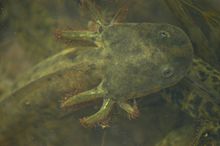California tiger cross-toothed newt
| California tiger cross-toothed newt | ||||||||||||
|---|---|---|---|---|---|---|---|---|---|---|---|---|

California tiger newt ( Ambystoma californiense ) |
||||||||||||
| Systematics | ||||||||||||
|
||||||||||||
| Scientific name | ||||||||||||
| Ambystoma californiense | ||||||||||||
| Gray , 1853 |
The California Tiger cross tooth scraper ( Ambystoma californiense ) is endemic in California occurring tailed amphibian (caudata) from the superfamily of Salamander relatives (Salamandroidea).
features
The California tiger cross-toothed newt reaches an average total length of 20 centimeters for males and 17 centimeters for females. The skin is smooth and shiny. The head, back, flanks and tail are jet black and have a few, mostly circular, yellow or cream-colored spots. The underside is colored gray without drawing. The mouth is very wide and shovel-shaped. The palatal teeth are arranged in transverse rows. Males can be recognized by the more strongly developed cloaca . The larvae that live in the water and have gills are gray-green. In terms of color and drawing, the species is similar to the spotted newt ( Ambystoma maculatum ). However, since this occurs exclusively in the east and middle of North America, there is no geographical overlap between the two species.
distribution and habitat
The distribution area of the California tiger cross-toothed newt is located in several, non-connected areas in western California and extends south of Sacramento and east of San Francisco to the north of Bakersfield . Adult animals live in open forest landscapes and like to hide in burrows dug by rodents. Their larvae prefer to inhabit small, fish-free waters. The altitude distribution ranges from sea level to around 1200 meters.
Way of life and development
Adult individuals feed primarily on various insects and worms. Their young animals living in the water and equipped with gills first eat algae, small crustaceans and aquatic insect larvae in the first six weeks, after which worms, snails and tadpoles are also accepted as food. At the beginning of the rainy season, usually from November onwards, the eggs are attached to aquatic plants or stones by the females after mating on the edge of small pools, individually or in small groups. On average, 814 eggs (maximum 1340) with a diameter of 3.5 millimeters are deposited. The larvae hatch after two to four weeks. The metamorphosis , ie the transformation of the aquatic tadpole to the terrestrial form, takes place after two years at the earliest, but it can also take up to four years. The animals become sexually mature after a development time between four and six years.
Danger
Due to the population growth in California and the associated construction of residential areas and roads as well as the development of agricultural areas, the species is in decline in some areas. It is therefore classified as ![]() ( vulnerable = endangered) by the World Conservation Organization IUCN . As rodent populations are also being controlled and declining in some areas, the California tiger cross-toothed newts are lacking many of the necessary hiding places in holes in the ground. Introduced animals, such as exotic fish or bullfrog species, are increasingly posing a threat to the larvae. The use of pesticides also has a negative effect on the amphibians' available food spectrum.
( vulnerable = endangered) by the World Conservation Organization IUCN . As rodent populations are also being controlled and declining in some areas, the California tiger cross-toothed newts are lacking many of the necessary hiding places in holes in the ground. Introduced animals, such as exotic fish or bullfrog species, are increasingly posing a threat to the larvae. The use of pesticides also has a negative effect on the amphibians' available food spectrum.
Individual evidence
- ↑ a b c Kassie Siegel & Sally Tomlinson: Petition to list the Sonoma County population of the California tiger salmander as endangered under the Endangered Species Act on an emergency basis , Center for Biological Diversity and Citizens for a Sustainable Cotati, petitioners, 2001 http: //www.biologicaldiversity.org/species/amphibians/California_tiger_salamander/pdfs/PETITION.PDF
- ↑ a b c d H. Bradley Shaffer & Peter C. Trenham: Ambystoma californiense , AmphibiaWeb, University of California, Berkeley, CA, USA, (viewed at http://amphibiaweb.org/cgi/amphib_query?where-genus=Ambystoma&where -species = californiense on July 25, 2017)
- ^ IUCN Red List
Web links
- California salamanders - photos
- Californian tiger newt (Ambystoma californiense) in the Encyclopedia of Life . Retrieved August 11, 2017.

